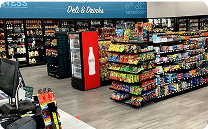In This article
A wireless camera is designed to send video and audio data over a wireless connection, most often Wi-Fi, rather than through hardwired connections like coaxial or Ethernet cables. While the term “wireless” generally refers to data transmission, it’s important to note that most of these cameras still require a power source, unless they are battery- or solar-powered models.
There are two primary types of wireless cameras:
- Wi-Fi Cameras connect to standard wireless networks and transmit footage to a network video recorder (NVR), local server, or cloud storage platform.
- Wire-free cameras are untethered and typically powered by rechargeable batteries or solar panels. They are useful in temporary or hard-to-reach installations.
Wireless Camera Advantages
Wireless cameras offer key advantages for business and industrial use. One of the most significant is installation flexibility. Without the need to run physical cables, these cameras can be mounted in locations where wiring would be costly, time-consuming, or disruptive, such as parking lots, building exteriors, historic sites, or active construction zones.
In addition, wireless systems are easier to scale. Organizations can add a wireless camera without overhauling their infrastructure as surveillance needs grow. Many wireless cameras are designed with plug-and-play functionality, making deployment faster and less dependent on IT or security specialists.
Modern wireless cameras can also integrate advanced features powered by artificial intelligence, including:
- Motion and intrusion detection.
- Facial recognition.
- People and vehicle tracking.
- License plate recognition.
- Real-time alerts and searchable event tagging.
Because wireless cameras are often cloud-connected, these AI features can be processed off-site, reducing the need for powerful local servers and enabling real-time insights accessible from any device with an internet connection.
Wireless Camera Considerations
Wireless surveillance solutions are used across a wide variety of sectors.
- Retail or C-stores – they provide discreet monitoring without compromising store aesthetics.
- QSRs – wireless cameras provide transaction visibility, which can prevent fraudulent activity.
- Warehousing and logistics – they oversee loading docks and inventory areas that may be challenging to hardwire.
Corporate campuses, schools, and hospitality venues benefit from their clean installations and flexible coverage, while outdoor facilities often rely on solar-powered models to avoid trenching or digging.
However, wireless cameras also come with some considerations:
- Network bandwidth is a critical factor, especially with high-definition video. Multiple cameras streaming footage simultaneously can slow down a network if it’s not adequately provisioned.
- Signal interference from thick walls, metal structures, or competing devices can affect reliability.
- Power requirements still apply unless the camera is truly wire-free, in which case, battery life and maintenance schedules must be managed.
- Security risks exist if networks are not properly encrypted, password-protected, or updated regularly.
Despite these limitations, wireless cameras offer a compelling option for many organizations. They combine ease of installation with modern surveillance features, allowing businesses to deploy smart, responsive security coverage in places where traditional wired systems may not be practical. With proper planning and a secure network infrastructure, wireless cameras can significantly enhance a site’s safety, oversight, and operational awareness.
Flexible Surveillance Starts with DTiQ
A wireless camera offers the freedom to monitor what matters, without the limitations of hardwired systems. The 360iQ platform helps you take full advantage of wireless surveillance with scalable solutions that combine flexible deployment, cloud connectivity, and intelligent analytics. Whether securing a single location or managing dozens, DTiQ solutions deliver the visibility and insights you need to protect your people, assets, and operations—anytime, anywhere. Schedule a demo today.





























